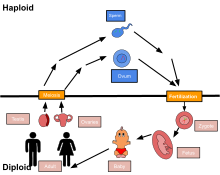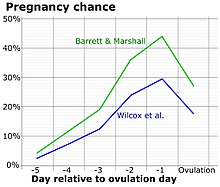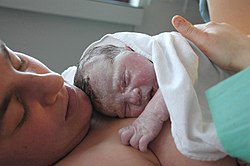How Are Babies Made How Are Humans Made
Human reproduction is whatever form of sexual reproduction resulting in human being fertilization. Information technology typically involves sexual intercourse between a sexually mature male and female. During sexual intercourse, the interaction between the male and female reproductive systems results in fertilization of the woman's ovum by the human's sperm. These are specialized reproductive cells called gametes, created in a process called meiosis. While normal cells contain 46 chromosomes, 23 pairs, gamete cells only contain 23 chromosomes, and information technology is when these ii cells merge into one zygote cell that genetic recombination occurs and the new zygote contains 23 chromosomes from each parent, giving them 23 pairs. A typical 9-month gestation period is followed by childbirth. The fertilization of the ovum may be achieved by artificial insemination methods, which do not involve sexual intercourse. Assisted reproductive technology also exists.
Biological and legal requirements [edit]
In order for human being reproduction to exist achieved, an individual must have undergone puberty starting time, requiring the ovulation of a female and the spermarche of a male to have occurred prior to engaging in sexual intercourse or achieving pregnancy through non-penetrative means. Earlier puberty, humans are infertile, as their genitals lack reproductive function (only being able to discharge urine).
Legal factors also play a vital part in the achievement of human reproduction: a minor under the age of consent cannot give legal consent to sexual intercourse or artificial alternatives to reproduction, the erstwhile case of which is liable to have the older party charged with statutory rape, depending on jurisdictions.[1] [2] Fifty-fifty for minors above the historic period of consent, comprehensive sexual activity education advises both consenting parties to use contraception to avoid both sexually transmitted diseases and early, unplanned/unwanted pregnancies. Pregnancy in girls nether the historic period of 15 is peculiarly discouraged due to their reproductive systems having even so to reach full maturity.[3]
Anatomy [edit]

Lao students study a display about the human reproductive organisation. Exhibits such as this are rare in many less-developed countries, such equally Laos. This result was held by Big Brother Mouse, a literacy and educational activity project, which added Lao explanations to a commercially available set of panels that were printed with English.
Human male [edit]
The male person reproductive system contains two main divisions: the testes where sperm are produced, and the penis which discharges the sperm as semen (this is known as an ejaculation). In humans, both of these organs are exterior the intestinal cavity. Having the testes outside the belly facilitates temperature regulation of the sperm, which require specific temperatures to survive about 2-3 °C less than the normal body temperature i.e. 37 °C. In particular, the extraperitoneal location of the testes may upshot in a 2-fold reduction in the heat-induced contribution to the spontaneous mutation charge per unit in male germinal tissues compared to tissues at 37 °C.[4] If the testicles remain too close to the torso, it is likely that the increase in temperature will damage the spermatozoa formation, making conception more difficult. This is why the testes are carried in an external scrotum rather than within the abdomen; they ordinarily remain slightly cooler than body temperature, facilitating sperm production.[ citation needed ]
Human female person [edit]
The female reproductive system likewise contains two chief divisions: the vagina and the ovum.
The ovum meets with the sperm cell: a sperm may penetrate and merge with the egg, fertilizing it with the help of certain hydrolytic enzymes nowadays in the acrosome. The fertilization usually occurs in the oviducts, but tin happen in the uterus itself. The zygote then becomes implanted in the lining of the uterus, where it begins the processes of embryogenesis and morphogenesis. When the fetus is developed plenty to survive outside of the uterus, the cervix dilates and contractions of the uterus propel it through the birth canal, which is the vagina, and thereby gives external life to the newborn babe. This process is chosen childbirth.
The ova, which are the female sex cells, are much larger than the spermatozoon and are normally formed inside the ovaries of the female person fetus before its nascency. They are mostly stock-still in location within the ovary until their transit to the uterus, and incorporate nutrients for the later zygote and embryo. Over a, usually, regular interval known every bit the menstrual bicycle, in response to hormonal signals, a process of oogenesis matures one ovum which is released and sent down the Fallopian tube. If non fertilized, this egg is flushed out of the organization through flow.
Process of fertilization [edit]

This model of the biological life cycle of a human shows the basic processes involved and the society that they are in.

Human reproduction normally begins with copulation, and it is followed past nine months of pregnancy before childbirth, though it may exist achieved through bogus insemination. Pregnancy can be avoided with the utilize of contraceptives such as condoms and intrauterine devices.
Copulation [edit]
Human reproduction naturally takes place as internal fertilization by sexual intercourse. During this process, the male inserts his penis, which needs to be cock, into the female'south vagina, and so either partner initiates rhythmic pelvic thrusts until the male ejaculates semen, which contains sperm, into the vaginal canal. The sperm and the ovum are known as the gametes (each containing half the genetic data of the parent, created through meiosis). The sperm (being one of approximately 250 million sperm in a typical male ejaculation) travels through the vagina and neck into the uterus or Fallopian tubes. Only 1 in 14 1000000 of the ejaculated sperm will attain the Fallopian tube. The egg simultaneously moves through the Fallopian tube away from the ovary. One of the sperm encounters, penetrates and fertilizes the ovum, creating a zygote. Upon fertilization and implantation, gestation of the fetus then occurs within the female'southward uterus.[5] [6] [vii] [8]

Pregnancy rates for sexual intercourse are highest during the menstrual cycle fourth dimension from some v days before until 1 to two days after ovulation.[x] For optimal pregnancy hazard, in that location are recommendations of sexual intercourse every one or 2 days,[11] or every 2 or 3 days.[12] Studies have shown no significant difference between different sex positions and pregnancy rate, as long as information technology results in ejaculation into the vagina.[13]
Alternative methods [edit]
As an alternative to natural sexual intercourse, at that place exists artificial insemination, where sperm is introduced into the female reproductive system without the insertion of the penis. There are also many methods of assisted reproductive technology, such every bit in vitro fertilization, where ane or more egg cells are retrieved from a adult female's ovaries and co-incubated with sperm outside the torso. The resulting embryo can then be reinserted into the woman'due south womb.
Pregnancy [edit]
Pregnancy is the period of time during which the fetus develops, dividing via mitosis inside the female person. During this time, the fetus receives all of its nutrition and oxygenated blood from the female person, filtered through the placenta, which is attached to the fetus' belly via an umbilical cord. This drain of nutrients can exist quite taxing on the female, who is required to ingest slightly higher levels of calories. In addition, certain vitamins and other nutrients are required in greater quantities than normal, often creating aberrant eating habits. Gestation menstruum is about 266 days in humans. While in the uterus, the baby first endures a very brief zygote stage, then the embryonic stage, which is marked by the development of major organs and lasts for approximately viii weeks, then the fetal stage, which revolves around the development of bone cells while the fetus continues to grow in size.[14]
Nascence [edit]

Newborn infant and mother
Once the fetus is sufficiently developed, chemic signals begin the process of birth, which begins with the fetus being pushed out of the birthing culvert. The newborn, which is called an infant in humans, should typically brainstorm respiration on its own shortly after nativity. Not long after, the placenta eventually falls off on its own. The person assisting the birth may also sever the umbilical cord.
See also [edit]
- Heterosexuality
- Antinatalism
- Evolution of sexual reproduction
- Female infertility
- Human being Reproduction (journal)
- Journal of Human Reproductive Sciences
- Male infertility
- Natalism
- Paternal historic period upshot
- Reproduction
- Reproductive system
- Legislation on human reproduction
- Reproductive health
References [edit]
- ^ Carmen M. Cusack (2015). Laws Relating to Sex activity, Pregnancy, and Infancy: Issues in Criminal Justice. Springer. p. 10. ISBN978-1137505194 . Retrieved August 31, 2021.
Voluntary sexual intercourse with a post-pubescent minor who is younger than the legal age of consent is described every bit statutory rape. [...] In most states, historic period of consent is delimited between 16 years old and 18 years old. [...] In almost every jurisdiction, prepubescent children may not engage in whatever sexual contact. [...] Engaging in sexual contact with a prepubescent kid is a serious criminal offense and a felony.
- ^ "Statutory Rape Known to Constabulary Enforcement" (PDF). U.S. Department of Justice - Office of Juvenile Justice and Delinquency Prevention. Retrieved 2021-08-31 .
- ^ Mayor S (2004). "Pregnancy and childbirth are leading causes of death in teenage girls in developing countries". BMJ. 328 (7449): 1152. doi:ten.1136/bmj.328.7449.1152-a. PMC411126. PMID 15142897.
- ^ Baltz RH, Bingham PM, Drake JW (1976). "Oestrus mutagenesis in bacteriophage T4: The transition pathway". Proc. Natl. Acad. Sci. USA. 73 (4): 1269–1273. Bibcode:1976PNAS...73.1269B. doi:10.1073/pnas.73.four.1269. PMC430244. PMID 4797.
{{cite journal}}: CS1 maint: multiple names: authors list (link) - ^ Ghazal, S, Kulp Makarov, J; et al. (2014). "Egg Transport and Fertilization". The Global Library of Women's Medicine. doi:x.3843/GLOWM.10317. ISSN 1756-2228. Retrieved May 8, 2016.
{{cite journal}}: CS1 maint: multiple names: authors listing (link) - ^ "Conception: How It Works". The Regents of The University of California. 2002. Retrieved May 8, 2016.
- ^ "Fertility Basics". Consummate Fertility Centre Southampton. Complete Fertility Ltd. 2015. Retrieved May 8, 2016.
- ^ "Conception & Pregnancy: Ovulation, Fertilization, and More". WebMD, LLC. 2016. Retrieved May eight, 2016.
- ^ Dunson, D.B.; Baird, D.D.; Wilcox, A.J.; Weinberg, C.R. (1999). "Day-specific probabilities of clinical pregnancy based on 2 studies with imperfect measures of ovulation". Human Reproduction. 14 (7): 1835–1839. doi:ten.1093/humrep/14.7.1835. ISSN 1460-2350. PMID 10402400.
- ^ Pages.242,374 in: Weschler, Toni (2002). Taking Accuse of Your Fertility (Revised ed.). New York: HarperCollins. pp. 359–361. ISBN0-06-093764-5.
- ^ "How to get pregnant". Mayo Clinic. 2016-11-02. Retrieved 2018-02-16 .
- ^ "Fertility bug: assessment and treatment, Clinical guideline [CG156]". National Institute for Health and Care Excellence . Retrieved 2018-02-16 . Published date: February 2013. Last updated: September 2017
- ^ Dr. Philip B. Imler & David Wilbanks. "The Essential Guide to Getting Pregnant" (PDF). American Pregnancy Association. Archived from the original (PDF) on 2018-06-01. Retrieved 2018-02-16 .
- ^ Feist, Gregory J.; Rosenberg, Erika L. (11 October 2011). Psychology: Perspectives and Connections (Second ed.). McGraw Hill. pp. (171–172). ISBN978-0-07-803520-3.
Altrui - The Human Egg Cell Explained
Farther reading [edit]
- Hopwood, Nick, Rebecca Flemming, Lauren Kassell, eds. Reproduction: Antiquity to the Present Mean solar day (Cambridge Upward, 2018). Illustrations. xxxv + 730 pp. ISBN 978-ane-107-06802-5 excerpt also online review 44 scholarly essays by historians.
Source: https://en.wikipedia.org/wiki/Human_reproduction
0 Response to "How Are Babies Made How Are Humans Made"
Post a Comment